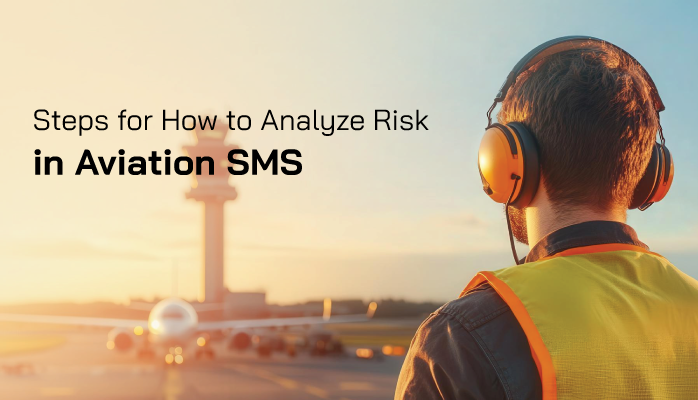What Information You Need to Analyze Risk

In aviation SMS, you analyze risk in order to identify how a particular issue affects safety. Based on your analysis, you can assess the safety issue, thereby ranking the level of risk and understanding what, if any, actions you need to take on the issue.
When you analyze the risk of an issue, you should be looking out for specific parts of the issue, such as:
- What the issue in question is – is the reported issue a hazard, a negative outcome, etc.
- What the primary hazard occurrence associated with this issue is;
- What the most likely negative outcome is;
- What the root causes and contributory factors are;
- How severe the issue is; and
- The chances that the issue will happen again.
To analyze risk in a reported issue, you will need to have:
- A narrative of what happened, which should describe what happened from start to finish; and
- Important metadata of the issue that you might gather from a custom hazard reporting form, such as:
- Time/place it occurred,
- Who was involved,
- Relevant information about tasks/missions associated with the issue (i.e., Flight number, maintenance task, etc.),
- And so on.
The more information you have at your disposal when analyzing risk, the better.
Good Tools for Risk Analysis
You can analyze risk with a variety of tools. Some operators will choose to perform risk analysis with just one comprehensive tool, whereas other operators use specific risk analysis tools for different types of analysis. Here are some tools you can use:
- Fishbone diagrams;
- 5 Whys Analysis;
- Issue Life Cycle Analysis;
- Risk Statement (hazard/risk identification);
- Bowtie analysis (advanced);
- Decision trees;
- Shortfall analysis (used to identify potential corrective actions).
These tools will help you identify and segment the narrative
Step 1: Establish What Issue Is Being Reported
Step one for risk analysis is to understand what exactly was reported. Employees report everything from:
- Benign problem or condition (“faulty hydraulic door stopper”);
- A root cause of a potential problem (“faulty runway bulb causing glaring light”);
- A potential unsafe situation/behavior (“pilot acting sleepy”);
- A potential threat (“flock of geese flying within 1 mile of primary runway”);
- A hazard occurrence (“runway incursion”); or
- An actual negative outcome (“water spilled on the primary server, causing it to malfunction”).
How you analyze risk depends quite a bit on what was reported.
For our analysis, we will use the following example scenario to provide a reference: “Cockpit door not closed properly before deicing because there was no procedure to do so and ground crew and flight crew did not coordinate their tasks. Fumes from deicer spray leaked into aircraft and made several passengers seriously ill.”
Related Aviation SMS Risk Analysis Articles
- What Is Process for Risk Analysis in Aviation SMS
- 5 Outcomes for Risk Analysis Activities in Aviation SMS
- Life Cycle of Hazard and Risk Occurrence in Aviation SMS
Step 2: Identify Primary Hazard

The hazard occurrence will be your starting point for understanding the issue.
To find the hazard occurrence, you need to look at the narrative of the issue. In this narrative, you are looking for the point at which a dangerous condition arises. This is:
- An object, situation, or circumstance that poses an unacceptable level of danger;
- A condition that arises only once in the narrative;
- May lead to (or did lead to, if a negative outcome is reported) a negative outcome if not mitigated; and
- A condition that arises from identifiable mechanisms (objects, behaviors) that occurred earlier in the narrative.
The reported issue may or may not have an identifiable hazard. In cases where benign issues are reported, you don’t really have a “dangerous condition” to identify.
Other times, the reported issue may be a proactive identification of concerns before hazard occurrence. In this case, you will need to make your best guess at what hazard WOULD HAVE occurred had the issue not been proactively identified.
Finally, sometimes the reported issues will focus on a negative outcome and provide no details about the hazard occurrence that led to those outcomes. In this case, you will have to speak to relevant personnel to get more data about what happened. In our example scenario, the hazard is when the ground crew started deicing while the aircraft door was open.
For more information about what a hazard is and how to identify it, see the resource below.
Related Aviation Hazard Identification Articles
- What Is a Hazard in Safety Management Systems
- How to Identify Hazards in Aviation SMS
- 4 Tips to Approach Hazard Identification in Aviation SMS
Step 3: Analyze Issue for Most Likely Negative Outcome
After identifying the hazard, you need to identify the most likely negative outcome that the identified hazard can lead to.
As discussed in the last section, the reported issue may already have a negative outcome. In this case, you don’t need to perform further analysis on the negative outcome because the issue reporter already provided it for you.
If a negative outcome did not occur, such as in the event that employees identified the dangers before the negative outcome, you will need to identify what the most likely negative outcome of your identified hazard is.
“If [hazard]…Then [bad outcome]…” risk statements are a good way to establish the most likely negative outcome. In our example scenario, we would identify our negative outcome as
- If the ground crew starts deicing aircraft while the aircraft door is not secured,
- Then deicing reagent can seriously injure multiple passengers.
In the example scenario, the negative outcome is multiple customer injuries.
Related Aviation Trending Analysis Articles
- How to Analyze Safety Reporting Performance in Aviation SMS Using Charts
- 5 Ways to Analyze Risk in Aviation SMS Implementations
- How to Distinguish Hazard vs Risk Occurrence
Step 4: Identify Root Causes
An integral part of risk analysis is analyzing the issue for root causes. Root causes are the existing conditions and behaviors (i.e., mechanisms) that conspire together to lead to hazard occurrence. Another way of saying it is that root causes play a “causal” role in hazard occurrence.
It’s useful to have a Hazard/Because root cause statement. It looks like this, using our example scenario:
- Ground crew started the deicing procedure while the aircraft door was open,
- Because there was no existing step in policy to check for closed doors and a lack of task coordination (communication) between different crews.
You should document your root causes, such as via classifications, for later data mining.
Related Aviation Root Cause Analysis Articles
- Understanding "Root Cause Analysis" Charts in Aviation SMS Dashboards
- 3 Methods for Root Cause Analysis in Aviation SMS
- How to Conduct Root Cause Analysis in Aviation SMS
Step 5: Identify Contributory Factors
Contributory factors are similar to root causes, but whereas root causes directly result in problems (i.e. they are “causal”), contributory factors are simply other factors that may intensify or “speed up” the transition from root causes to hazard occurrence.
You may be able to identify contributory factors in the narrative, or you may have to inquire more information. To use our narrative example, we might do further research into the issue and discover that some contributory factors were:
- This was the airline’s first winter operating in cold climates; and
- Windy days contributed to billowing higher amounts of deicing reagent into aircraft.
In both cases, these factors were not “causal”, but they certainly contributed to the hazard occurrence and negative outcome.
You should document your contributory factors, such as via classifications, for later data mining.
Step 6: Analyze Issue for Risk Severity

Once you understand the entire scope of the issue, you need to analyze the severity of the negative outcome. The steps are as follows:
- List your criteria for severity on your risk matrix, such as:
- Financial damage
- Human injury
- Mission obstruction
- Environmental damage
- Analyze the negative outcome with each of your criteria:
- Litigation damages = $485,000
- Serious injury to multiple people, requiring hospitalization
- Single mission aborted (flight aborted)
- No environmental damage
- Match up the damage with the level of severity defined in your risk matrix, such as if our risk matrix indicated that the above damages were:
- Financial: severity level 4
- Human injury: severity level 4
- Mission obstruction: severity level 3
- Environmental: severity level 1
You will use this analysis to decide on the overall severity of the issue during risk assessment.
Related Aviation SMS Risk Matrix Articles
- What Is a Risk Matrix and Risk Assessment in Aviation SMS
- How to Define Your Risk Matrix in Aviation SMS
- How to Create Your Risk Matrix for Risk Assessments in Aviation SMS
Analyze Issue for Risk Likelihood
You also need to analyze the issue for the future likelihood that the negative outcome will occur in the event of the hazard occurrence. The steps for this are:
- Review trends and historical data on similar issues to establish how common this occurrence actually is; and
- Review existing risk controls that are used to mitigate this negative outcome.
Based on this analysis, you should have a good idea of whether this negative outcome is frequent, somewhat common, rare, etc. You will use this analysis during risk assessment to assign a likelihood level to the issue.
In our example narrative, we would identify this as the first occurrence in an organization and as very rare in the industry. Based on this, we might eventually assign a likelihood assessment of the “Isolated issue.”
Last updated in July 2025.






